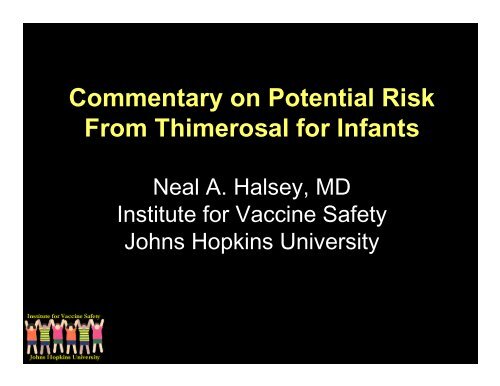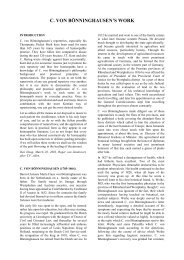Neal Halsey-Recommendations for Newborn and Infant Hepatitis B ...
Neal Halsey-Recommendations for Newborn and Infant Hepatitis B ...
Neal Halsey-Recommendations for Newborn and Infant Hepatitis B ...
You also want an ePaper? Increase the reach of your titles
YUMPU automatically turns print PDFs into web optimized ePapers that Google loves.
Commentary on Potential Risk<br />
From Thimerosal <strong>for</strong> <strong>Infant</strong>s<br />
<strong>Neal</strong> A. <strong>Halsey</strong>, MD<br />
Institute <strong>for</strong> Vaccine Safety<br />
Johns Hopkins University
Key Points<br />
• What is the maximum safe dose of thimerosal<br />
that can be administered on one day?<br />
• Is ethylmercury from thimerosal additive to<br />
methylmercury?<br />
• Not: Vaccinating vs not vaccinating. It is<br />
making vaccines as safe as possible.
FDA Risk Assessment<br />
• Initial reaction to FDA assessment:<br />
• surprise, disbelief<br />
• Calculations correct<br />
• Why missed?<br />
• Label: thimerosal concentration (.01%)<br />
• Guidelines <strong>for</strong> exposure to Hg in ug
Thimerosal is Neurotoxic<br />
in Large Doses<br />
• HBIG <strong>and</strong> IVIG<br />
• Lowell. Lancet 1996;347:380<br />
• Matheson. J Pediatr 1980;97:153<br />
• IM Chloramphenicol<br />
• Axton. Postgrad Med J 1972;48:417<br />
• Painting omphaloceles<br />
• Fagan. Arch Dis Child 1977;52:962<br />
• Irrigation of ears<br />
• Rohyans. J Pediatr 1984;104:311<br />
• What is safe <strong>for</strong> the developing brain?
FDA Risk Assessment<br />
Maximum Cumulative Exposure<br />
• Routine schedule:<br />
• Birth, 2, 4, 6 months<br />
• 187.5 ug maximum<br />
• Exceeded EPA RfD <strong>for</strong> most children<br />
• Exceeded ATSDR <strong>for</strong> < 5 th percentile<br />
Ball L. Pediatrics 2001;107(5):1147-54
FDA Risk Assessment<br />
Maximum Cumulative Exposure<br />
• Accelerated immunization schedule:<br />
• Birth, 6, 10, 14 weeks<br />
• Pertussis outbreaks, travel to developing<br />
countries<br />
• Exceeded ATSDR guidelines <strong>for</strong> many<br />
children<br />
WHO. Wkly Epi Record 2000;2:12.
What Time Period Should be Used<br />
<strong>for</strong> Cumulating Exposures?<br />
• Birth to 6 months? 187.5 ug<br />
• Birth to 3 months-accelerated schedule?<br />
175 ug?<br />
• Birth to 2 months? 75 ug<br />
• One day? 62.5 ug
Weight in Kg <strong>for</strong> Girls<br />
by Percentile <strong>and</strong> Age<br />
Percentile<br />
Age -3 SD 5th 50th 95th<br />
Birth 1.8 2.4 3.2 3.8<br />
2 mo 2.7 3.6 4.7 5.8<br />
4 mo 3.7 4.7 6 7.4<br />
6 mo 4.6 5.8 7.2 8.7<br />
Epi info: CDC
Mercury (ug/Kg) Administered by Age <strong>and</strong><br />
Weight If Thimerosal-containing Vaccines<br />
Are Given <strong>for</strong> <strong>Hepatitis</strong> B, Hib, <strong>and</strong> DTaP<br />
25<br />
Mercury: ug/kg<br />
20<br />
15<br />
10<br />
5<br />
Weight of Child<br />
-3 SD<br />
5th Percentile<br />
50th Percentile<br />
95th Percentile<br />
0<br />
Birth 2 4 6<br />
Age (in months)<br />
*ATSDR<br />
Amount of Hg received (in micrograms) = 12.5 at birth,<br />
62.5 at 2 & 6 months, 50 at 4 months
Mercury (ug/Kg) Administered by Age <strong>and</strong><br />
Weight If Thimerosal-containing Vaccines<br />
Are Given <strong>for</strong> <strong>Hepatitis</strong> B, Hib, <strong>and</strong> DTaP<br />
25<br />
Mercury: ug/kg<br />
20<br />
15<br />
10<br />
5<br />
mo*<br />
Weight of Child<br />
-3 SD<br />
5th Percentile<br />
50th Percentile<br />
95th Percentile<br />
wk<br />
0<br />
Birth 2 4 6<br />
Age (in months)<br />
d<br />
*ATSDR<br />
Amount of Hg received (in micrograms) = 12.5 at birth,<br />
62.5 at 2 & 6 months, 50 at 4 months
Mercury (ug/Kg) Administered by Age <strong>and</strong><br />
Weight If Thimerosal-containing Vaccines<br />
Are Given <strong>for</strong> <strong>Hepatitis</strong> B, Hib, <strong>and</strong> DTaP<br />
25<br />
Mercury: ug/kg<br />
20<br />
15<br />
10<br />
5<br />
mo*<br />
mo @<br />
wk<br />
Weight of Child<br />
-3 SD<br />
5th Percentile<br />
50th Percentile<br />
95th Percentile<br />
0<br />
Birth 2 4 6<br />
Age (in months)<br />
d<br />
*ATSDR<br />
@EPA<br />
Amount of Hg received (in micrograms) = 12.5 at birth,<br />
62.5 at 2 & 6 months, 50 at 4 months
Amount of Mercury Administered<br />
If Only One Thimerosal-containing<br />
Vaccine Is Given (Hib or DTaP)<br />
25<br />
Mercury: ug/kg<br />
20<br />
15<br />
10<br />
5<br />
0<br />
Birth 2 4 6<br />
Age (in months)<br />
mo*<br />
mo @<br />
wk<br />
d<br />
Weight of Child<br />
-3 SD<br />
5th Percentile<br />
50th Percentile<br />
95th Percentile<br />
*ATSDR<br />
@EPA
Summary of MeHg<br />
Reference Values<br />
Values<br />
AGENCY (ug/kg/day) TERMINOLOGY<br />
EPA 0.1 RfD<br />
FDA 0.4 ADI<br />
ATSDR 0.3 MRL<br />
WHO 3.3 ug/kg/wk PTWI
Committee on<br />
the<br />
Toxicological<br />
Effects of<br />
Methylmercury<br />
Board on<br />
Environmental<br />
Studies <strong>and</strong><br />
Toxicology<br />
Commission on<br />
Life Sciences<br />
National<br />
Research<br />
Council<br />
Washington DC<br />
National<br />
Academy Press<br />
2000
National Research Council Review<br />
of Methylmercury<br />
• RfD should be 0.1 ug/Kg/d<br />
• Over 60,000 children born per year at<br />
risk <strong>for</strong> neurodevelopmental effects<br />
• Other <strong>for</strong>ms of mercury should be<br />
taken into consideration
Fish<br />
Consumption<br />
Rates of Various<br />
Populations<br />
Source: EPA Mercury Study Report to<br />
Congress Volume 1: Executive<br />
Summary EPA-452/R-97-003, Dec 1997
PROTECT YOUR KIDS<br />
RELEASE YOUR CATCH<br />
Due to MERCURY CONTAMINATION of Inl<strong>and</strong> Waters;<br />
DO NOT EAT WARM WATER FISH SPECIES:<br />
If You Are Pregnant, Nursing, May Soon Become Pregnant or Are Less<br />
Than 8 Years Old<br />
Additionally, Consumption of Cold Water Species Should Be Limited to 1 Meal Per<br />
Month. Other Individuals Limit Consumption of Warm Water Species to 2-3 Meals Per<br />
Month.<br />
While providing certain health benefits, eating fish caught from these waters<br />
may also expose you to chemicals which can cause cancer, birth defects, <strong>and</strong><br />
learning disabilities. Animals like the bald eagle, loon, <strong>and</strong> otter are also at risk.<br />
Scientists have documented de<strong>for</strong>mities, reproductive problems, <strong>and</strong> tumors in<br />
fish, amphibians, mammals, birds, <strong>and</strong> other wildlife in polluted water bodies.<br />
This posting is a public service of the Maine Toxins Action Coalition [MTAC]<br />
For a full copy of the State consumption advisories <strong>and</strong> more in<strong>for</strong>mation on toxins in the<br />
environment call MTAC at 1-800-287-2345 or Maine Bureau of Health at 287-6455<br />
Maine fish consumption advisories are not restricted to mercury contamination.<br />
Non-posted waters should NOT be assumed to be free of contaminants.
Estimates of Methylmercury<br />
Levels in Women of Childbearing<br />
Age in the United States<br />
• EPA dietary consumption<br />
• 7% >.1 ug/Kg/d, 1% >.37ug/Kg/d<br />
• NRC modeling<br />
• 60,000 children born per year to mothers with<br />
elevated levels<br />
• CDC NHANES* blood mercury<br />
• Mean 1.2 ppb (90 th % 6.2 ppb)<br />
• 10% have levels within 1/10 th of potentially<br />
hazardous levels<br />
* MMWR 2001;50(08);140.
FDA Fish Advisory<br />
March 2001<br />
• Pregnant women <strong>and</strong> women of<br />
childbearing age should avoid:<br />
• Shark, mackerel, swordfish, tilefish<br />
• Swordfish ~1 ppm methylmercury<br />
• 28.5 ug Hg per ounce<br />
www.fda.gov/bbs/topics/ANSWERS/2001/advisory.html
July 1999<br />
• AAP/PHS joint statement<br />
• Could exceed guidelines <strong>for</strong> MeHg<br />
• Delay hep B vaccine <strong>for</strong> infants born to HBsAg<br />
negative women<br />
• Reduce or eliminate thimerosal<br />
• AAP interim report<br />
• Amounts of Hg in each vaccine<br />
• Limit exposure to Hg from other sources
Suggested Guidelines (1999) <strong>for</strong><br />
Limiting <strong>Infant</strong> Exposure to<br />
Thimerosal in Vaccines<br />
• Preference <strong>for</strong> vaccines without<br />
thimerosal preservative<br />
• No more than one vaccine with<br />
thimerosal preservative per regularly<br />
scheduled visit<br />
<strong>Halsey</strong> NA. JAMA 1999; 282(18):1763
DTaP, Hep B, <strong>and</strong> Hib Vaccines<br />
Without Thimerosal Preservative<br />
July 1999<br />
DTaP<br />
• Infanrix<br />
<strong>Hepatitis</strong> B<br />
• COMVAX<br />
Hib<br />
• ActHIB<br />
• Omni Hib<br />
• HibTITER<br />
Single dose<br />
• PedvaxHIB<br />
Liquid<br />
• COMVAX
DTaP, Hep B, <strong>and</strong> Hib Vaccines<br />
Without Thimerosal Preservative<br />
July 2001<br />
DTaP<br />
• Infanrix<br />
• Tripedia<br />
<strong>Hepatitis</strong> B<br />
• COMVAX<br />
• Recombivax HB<br />
“preservative free”<br />
• Engerix B<br />
“preservative free”<br />
Hib<br />
• ActHIB<br />
• Omni Hib<br />
• HibTITER<br />
Single dose<br />
• PedvaxHIB<br />
Liquid<br />
• COMVAX
AMERICAN ACADEMY OF PEDIATRICS<br />
Lynn R. Goldman, MD, MPH; Michael W. Shannon, MD, MPH; <strong>and</strong> the<br />
Committee on Environmental Health<br />
Technical Report: Mercury in the Environment:<br />
Implications <strong>for</strong> Pediatrics<br />
Pediatrics 2001;108(1):197
VSD Studies<br />
• Delayed speech, language, LD<br />
• Multifactorial etiologies<br />
• Large studies needed<br />
• Harvard Pilgrim study:<br />
• Power?<br />
• Data inconclusive, but suggestive of an<br />
effect from thimerosal
Why Additional Studies Are Needed<br />
• The public deserves an answer:<br />
• If toxicity, VICP?<br />
• Exposures continuing in other countries<br />
• Obligation to find answers<br />
• Assistance will be needed <strong>for</strong> removal if toxic<br />
effects demonstrated
Additional Studies Needed<br />
• CDC/NIH cohort follow-up study<br />
• Strongest design<br />
• Power uncertain <strong>for</strong> some outcomes<br />
• Power likely to be greater <strong>for</strong> more subtle<br />
effects<br />
• Other populations with high baseline<br />
methylmercury exposures<br />
• Case-control studies?
Animal Studies Needed<br />
• Is ethylmercury equivalent to<br />
methylmercury?<br />
• Is ethylmercury additive to<br />
methylmercury?<br />
• Are bolus doses more toxic than small<br />
daily doses?
Lessons from Thimerosal<br />
• FDA, manufacturers, <strong>and</strong> advisory bodies<br />
can mobilize <strong>and</strong> act rapidly when indicated<br />
to improve safety.<br />
• Actions taken have minimized potential risks<br />
to children from mercury<br />
• Public needs to be confident that vaccines<br />
are made as safe as possible
Encourage IOM to Stop Using:<br />
“The Evidence is Inadequate to<br />
Accept or Reject a Causal Relation”<br />
• Not in<strong>for</strong>mative<br />
• Overused -always some doubt<br />
• Misinterpreted as there is scientific<br />
evidence supporting hypotheses<br />
• <strong>Hepatitis</strong> B <strong>and</strong> MS<br />
• MMR <strong>and</strong> autism<br />
• Just summarize the evidence







